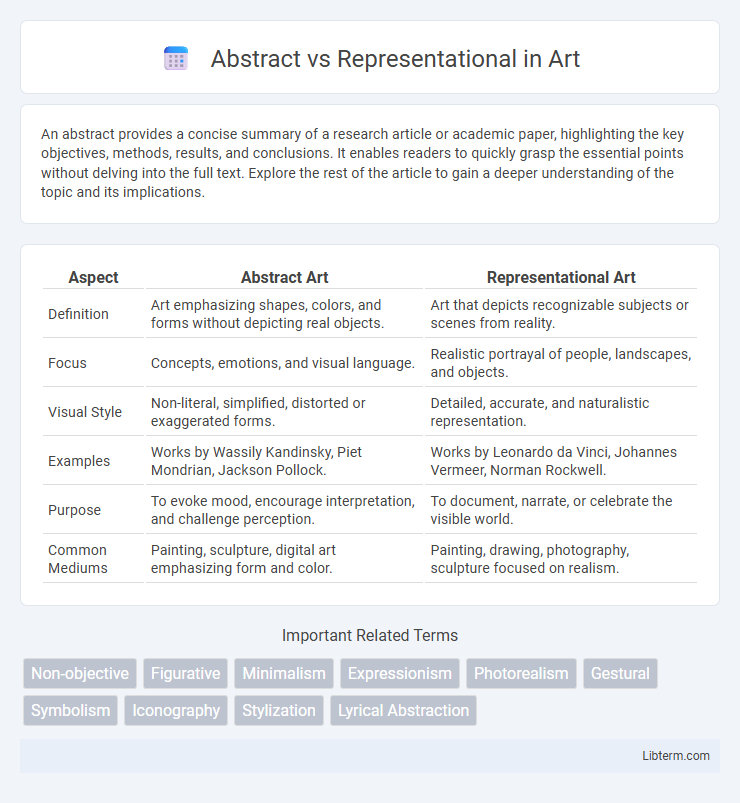An abstract provides a concise summary of a research article or academic paper, highlighting the key objectives, methods, results, and conclusions. It enables readers to quickly grasp the essential points without delving into the full text. Explore the rest of the article to gain a deeper understanding of the topic and its implications.
Table of Comparison
| Aspect | Abstract Art | Representational Art |
|---|---|---|
| Definition | Art emphasizing shapes, colors, and forms without depicting real objects. | Art that depicts recognizable subjects or scenes from reality. |
| Focus | Concepts, emotions, and visual language. | Realistic portrayal of people, landscapes, and objects. |
| Visual Style | Non-literal, simplified, distorted or exaggerated forms. | Detailed, accurate, and naturalistic representation. |
| Examples | Works by Wassily Kandinsky, Piet Mondrian, Jackson Pollock. | Works by Leonardo da Vinci, Johannes Vermeer, Norman Rockwell. |
| Purpose | To evoke mood, encourage interpretation, and challenge perception. | To document, narrate, or celebrate the visible world. |
| Common Mediums | Painting, sculpture, digital art emphasizing form and color. | Painting, drawing, photography, sculpture focused on realism. |
Understanding Abstract and Representational Art
Abstract art emphasizes shapes, colors, and forms without directly depicting real-world objects, allowing viewers to interpret emotions and ideas subjectively. Representational art, on the other hand, accurately portrays recognizable subjects and scenes from reality, making it accessible through familiar imagery. Understanding these distinctions helps viewers appreciate the intention behind artwork, whether focusing on conceptual expression or realistic depiction.
Defining Abstract Art: Key Characteristics
Abstract art emphasizes colors, shapes, and forms without depicting recognizable objects, prioritizing emotional expression and conceptual ideas over realistic representation. Key characteristics include non-representational imagery, use of geometric or freeform shapes, and an emphasis on visual elements like texture, line, and color to evoke moods or thoughts. This style often abandons traditional perspective and proportions, allowing artists to explore subjective interpretations beyond the visible world.
The Essence of Representational Art
Representational art captures the essence of real-world subjects by depicting recognizable forms that convey clear visual references, creating an immediate connection between the artwork and the viewer's perception. This art style emphasizes accurate detail, proportion, and perspective to communicate the artist's interpretation of reality while preserving the subject's identifiable features. Unlike abstract art, which prioritizes emotion and subjective interpretation through non-literal forms, representational art centers on the tangible and familiar, grounding its expression in observable reality.
Historical Evolution: Abstract vs Representational
The historical evolution of abstract versus representational art reveals distinct philosophical and stylistic shifts beginning in the late 19th century, with representational art prioritizing accurate depiction and abstract art emphasizing emotional expression and form. Early modern artists like Wassily Kandinsky and Piet Mondrian pioneered abstract art by breaking away from realistic portrayal, influencing movements such as Cubism and Expressionism. Representational art, rooted in classical traditions, continued to evolve through realism and impressionism, reflecting societal changes and technological advancements in visual documentation.
Techniques and Styles in Abstract Art
Abstract art employs techniques like gestural brushstrokes, color field washes, and geometric shapes to evoke emotions and concepts without direct representation. Styles range from the non-objective forms of Kandinsky to the textured, layered compositions of Abstract Expressionism. Representational art relies on techniques such as realistic shading, perspective, and proportion to depict recognizable subjects, contrasting with the abstract focus on form and color over literal accuracy.
Techniques and Styles in Representational Art
Representational art employs techniques such as realistic color palettes, linear perspective, and chiaroscuro to create lifelike images that closely mimic the visual world. Styles in representational art range from photorealism, which emphasizes intricate detail and accuracy, to impressionism, which captures the essence of a scene through visible brushstrokes and light effects. These approaches prioritize recognizable subject matter, allowing viewers to identify figures, landscapes, and objects with clarity and emotional resonance.
Communication and Interpretation in Both Styles
Abstract art communicates through shapes, colors, and forms that evoke emotions and ideas without direct representation, inviting viewers to interpret meaning based on personal experience. Representational art depicts recognizable subjects, making communication more straightforward by reflecting real-world objects or scenes, thereby guiding the viewer's understanding. Both styles engage audiences differently, with abstract art promoting subjective interpretation and representational art offering clearer, more immediate visual messages.
Prominent Artists in Abstract and Representational Movements
Wassily Kandinsky and Jackson Pollock are prominent figures in the abstract art movement, known for pioneering non-representational forms and emphasizing color and emotion over realistic depictions. In contrast, artists like Johannes Vermeer and Diego Velazquez exemplify representational art, mastering detailed, lifelike portrayals that focus on accurate representation of their subjects. These artists highlight the distinct priorities of abstract art's focus on internal experience compared to representational art's commitment to visual realism.
The Influence of Abstract and Representational Art in Modern Culture
Abstract art challenges traditional perceptions by emphasizing emotional expression and conceptual ideas, influencing modern culture through bold innovation and diverse interpretations. Representational art maintains a connection to the tangible world, preserving historical narratives and cultural identity within contemporary society. Together, these art forms shape modern aesthetic values, impacting design, media, and visual communication globally.
Choosing Between Abstract and Representational: What Suits Your Expression?
Choosing between abstract and representational art depends on your desired mode of expression and the emotions you wish to convey. Abstract art allows freedom in form, color, and interpretation, enabling the expression of intangible concepts and personal feelings without strict adherence to reality. Representational art emphasizes recognizable subjects and realistic detail, making it ideal for storytelling and conveying clear, universal messages through visual accuracy.
Abstract Infographic

 libterm.com
libterm.com